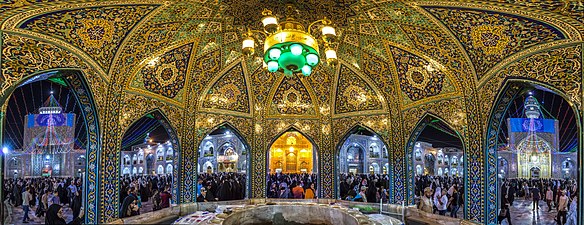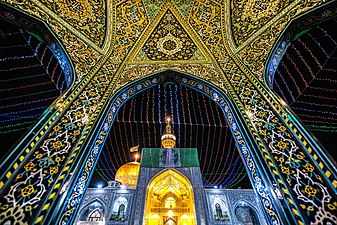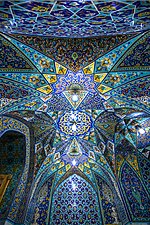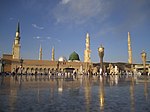Imam Reza shrine
| Imam Reza shrine | |
|---|---|
حرم امام رضا | |
 | |
| Religion | |
| Affiliation | Shia Islam |
| Leadership | Imam(s): Ahmad Alamolhoda |
| Location | |
| Location | Mashhad, Iran |
| Administration | Astan Quds Razavi |
| Geographic coordinates | 36°17′17″N 59°36′57″E / 36.2880°N 59.6157°E |
| Architecture | |
| Type | Mosque |
| Style | Abbasid Islamic |
| Date established | 818 |
| Specifications | |
| Capacity | 700,000 |
| Minaret(s) | 12 |
| Minaret height | 70 m (230 ft) |
| Site area | 1,000,000 square metres (250 acres) |
| Website | |
| www | |
The Imam Reza shrine (Persian: حرم امام رضا, romanized: Haram-e Emâm Rezâ, lit. 'Sanctuary of Imam Reza'), located in Mashhad, Iran, is an Islamic shrine containing the remains of Ali al-Rida, the eighth Imam of Shia Islam. It is the largest mosque in the world by area. Also contained within the complex are the Goharshad Mosque, a museum, a library, four seminaries,[1] a cemetery, the Razavi University of Islamic Sciences, and other buildings.
The complex is a tourism center in Iran[2][3] and has been described as "the heart of the Shia Iran"[4] with 25 million Iranian and non-Iranian Shias visiting the shrine each year, according to a 2007 estimate.[5]
The shrine itself covers an area of 267,079 square metres (2,874,810 sq ft) while the seven courtyards which surround it cover an area of 331,578 square metres (3,569,080 sq ft), totaling 598,657 m2 (6,443,890 sq ft).[6]
Religious significance
[edit]Shia sources quote several hadiths from the Shia Imams and Muhammad that highlight the importance of pilgrimage to the shrine. A hadith from Muhammad says:
One of my own flesh and blood will be buried in the land of Khorasan. God the Highest will surely remove the sorrows of any sorrowful person who goes on pilgrimage to his shrine. God will surely forgive the sins of any sinful person who goes on pilgrimage to his shrine.[7]
History
[edit]Early years
[edit]Dar-ul-Imarah (Royal Residence) or the garden of Humayd ibn Qahtaba al-Ta'i was a fortress in the village of Sanabad. It dates back to the era before the Islam religion. It had been placed at the fork road of Sanabad, Neishabour, Sarakhs, Toos and Radkan. This fortress had been a place for the frontier guards to take position and establish the security of these roads and regions. After the demise of Harun al-Rashid, he was buried in this place. Due to this historical event, the Dar-ul-Imarah was known as the Mausoleum of Haruniyyeh. The original inner building of Dar-ul-Imarah had been a Zoroastrian temple. This building was demolished by the order of al-Ma'mun, and then it was reconstructed according to the special architecture of Khorasan. Four plain and short walls, covered with a low-slope dome, were constructed around the building. Afterwards, the name of the mausoleum (Haruniyyeh) was changed and known as the Mashhad-ur-Reza. Mashhad literally means a place where a martyr has been buried.[8]
Martyrdom of Ali al-Ridha
[edit]
In 818, Imam Ali al-Ridha was murdered by the Abbasid caliph al-Ma'mun (ruled 813–833) and was buried beside the grave of al-Ma'mun's father, Harun al-Rashid (r. 786–809).[9] After this event, the location was called Mashhad al-Ridha ("the place of martyrdom of al-Ridha"). Shias and Sunnis (for example, Ibn Hibban wrote in his Kitab al Siqqat that whenever troubled and in Mashad he would always visit the shrine to ask for relief from problems that bothered him) began visiting his grave on pilgrimage. By the end of the 9th century, a dome was built on the grave and many buildings and bazaars sprang up around it. For the next thousand years, it has been devastated and reconstructed several times.[10]
The celebrated Muslim traveler Ibn Battuta visited Mashhad in 1333 and reported that it was a large town with abundant fruit trees, streams and mills. A great dome of elegant construction surmounts the noble mausoleum, the walls being decorated with colored tiles. Opposite the tomb of the Imam is the tomb of Caliph Harun al-Rashid, which is surmounted by a platform bearing chandeliers.[2]
Ghaznavid era
[edit]By the end of the third Hijri century, a dome was built on the grave of Imam Reza and many buildings and bazaars sprang around the shrine. In 383 A.H. / 993 A.D., Sebuktigin, the Ghaznavid sultan devastated Mashhad and stopped the pilgrims from visiting the shrine. But in 400 A.H./ 1009 A.D., Mahmud of Ghazni (born 971, ruled, 998-1030 A.D.) started the expansion and renovation of the shrine and built many fortifications around the city.[11]
Saljug era
[edit]
Sultan Sanjar (b. 1086 A.D., r. 1097–1157 A.D.), after the healing of his son in the shrine, renovated the sanctuary and added new buildings within its precincts. At the time of Sultan Sanjar Saljuqi, after Sharaf al-Din Abu Tahir b. Sa'd b. Ali Qummi repaired the shrine, he began to construct a dome over it.[12] In 612 A.H./ 1215 A.D., as borne out by inscriptions on certain tiles, Allaudin Khwarezm Shah carried out renovations on the shrine.[12]
Mongol invasion
[edit]During the Khwarazmian dynasty, some repair and decoration was made inside the shrine.[12] In this era (612 A.H./1215 A.D.), two very glorious embossed Thuluth (a large Naskh handwriting) inscriptions in form of square tile work were fixed on both sides of the shrine entrance-by the side of Dar al-Huffaz porch—in which the names and descent of Imam Reza back to Imam Ali were written. Some other inscriptions and three mihrabs (a special place for prayer-leader in mosques) belonging to this age exist in this holy complex. During the Mongol invasion in 1220 A.D. (617 A.H.), Khorasan was plundered by the invading hordes and the survivors of this massacre took refuge in Mashhad and settled around the shrine.[13] Sultan Muhammad Khudabandeh Iljaitu (b. 1282 AD), the Mongol ruler of Iran, converted to Shi'ism and ruled Iran in 703–716 A.H (1304–1316 AD), once again renovated the shrine on a grand scale.[11]
Timurid era
[edit]The glorious phase of Mashhad started during the reign of Shahrukh Mirza (b. 1377 A.D., r, 1405–1447), son of Tamerlane, and reached its zenith during the reign of the Safavid Shahs who ruled Iran from 1501 to 1736. Shahrukh Mirza, whose capital was Herat, regularly visited Mashhad for the pilgrimage of the shrine of Imam Reza (A.S.). In the 15th century, during the reign of the Timurid Shahrukh Mirza, Mashhad became one of the main cities of the realm. In 1418, his wife Empress Goharshad funded the construction of an outstanding mosque beside the shrine, which is known as the Goharshad Mosque.[14]
Safavid era
[edit]
With the emergence of the Safavid dynasty in 1501 A.D. and their declaration of the Twelver Shi'ite sect as the state religion, Mashhad reached the peak of its development. However, since Khorasan was a border province of the Safavid Empire, Mashhad suffered repeated invasions and periods of occupation by the Uzbek Khans – Muhammad Khan, Abdullah Khan Shaibani, Muhammad Sultan and especially Abdul-Momen Khan. These invasions continued up to 996 A.H./ 1586 A.D., the reign of Shah Abbas I, who finally drove out the Uzbeks from Khorasan. Sahn Atiq was extended in the time of Shah Abbas I, and during the Safavid era, efforts were made for its further improvement.
During the Safavid era, the shrine also received patronage from rulers of the Indian subcontinent, namely Quli Qutb-ul-Mulk (founder of the Qutb Shahi dynasty) and Mughal Emperor Akbar. The latter was notably a Sunni.[15]
Afsharid and Qajar era
[edit]

Nader Shah Afshar (b. 1688, r. 1736–1747 A.D.) and the Qajar Shahs who ruled Iran from 1789 to 1925 expanded the various places in the shrine. There were also some improvements in the shrine complex during the Qajar Dynasty. There was also some repair in both courtyards during Mozaffar ad-Din Shah's monarchy.
Following the coup in December 1911, Russian artillery shelled revolutionaries who had taken refuge in the shrine.[16] The whole complex was greatly damaged in 1911, but it was repaired after a while.
Modern era
[edit]
There were significant changes in the complex in 1928 (1347 A.H.). Old Falakah was extended up to a radius of 620 meters before the victory of the Islamic Revolution, and an important part of Holy Buildings' historical structure was demolished without considering its antiquity and elegance.
On 13 July 1935 (11th Rabi al-Thani 1354 A.H.), during the Goharshad Mosque rebellion, armed forces of Reza Shah (b. 1878, r. 1925–1941), the reigning monarch of Iran and founder of Pahlavi dynasty, invaded the shrine and massacred people gathered in the Goharshad Mosque. The people there were protesting against the modernization policies of the Shah which many, especially amongst the Shia clergy, considered to be anti-Islamic, including the banning of hijab (headscarf) for women in Iran. Shortly before the Iranian Revolution, on 21 November 1978, troops under orders from the regime of Mohammad Reza Shah (b. 1919, r. 1941–1979), Reza Shah's son and successor, killed a large number of people within the shrine (approximately 12,000[citation needed]).
The shrine is depicted on the reverse of the Iranian 100 rials coin, issued since 2004.[17]
Incidents
[edit]Commune kitchen
[edit]The harem kitchen dines 10 to 40 thousand visitors a day and sometimes on occasional events cooks for as many as 250,000. It has an Astan quds website page and there is an ID register and ticket lottery for a meal one course per person every three year.[18][19] During Ramadan Commune kitchen feed one million pilgrim and citizens.[20]
Specifications
[edit]
The complex contains a total of seven courtyards, which cover an area of over 331,578 m2 (3,569,080 sq ft):[21] The courtyards also contain a total of 14 minarets,[22] and three fountains.[23]
| Name | Images | Area (m2) | appurtenant | Year of first building |
|---|---|---|---|---|
| Islamic Revolution Courtyard | four balconies, steel window | [[{{{1}}}]] | ||
| Freedom Courtyard | 4,600 | golden Veranda | [[{{{1}}}]] | |
| Courtyard of Goharshad Mosque | [[{{{1}}}]] | |||
| Quds Courtyard | 2,500 | [[{{{1}}}]] | ||
| Islamic Republic Courtyard | 10,000 | two minarets | [[{{{1}}}]] | |
| The Razavi Grand Courtyard | [[{{{1}}}]] | |||
| Gadeer Courtyard | [[{{{1}}}]] |
Halls
[edit]From the courtyards, external hallways named after scholars lead to the inner areas of the mosque. They are referred to as Bast (Sanctuary), since they were meant to be a safeguard for the shrine areas:[24]
- Bast Shaykh Toosi – leads to the Central Library
- Bast Shaykh Tabarsi
- Bast Shaykh Hur Ameli
- Bast Shaykh Baha'i
The Bast hallways lead towards a total of 21 internal halls (Riwaq) which surround the burial chamber of Ali al-Ridha.[25] Adjacent to the burial chamber is also a mosque dating back to the 10th century known as, Bala-e-Sar Mosque.[26]
Goharshad Mosque
[edit]
This mosque is situated adjacent to the shrine of Imam Ridha.
Ali al-Ridha's Tomb
[edit]
It is located beneath the Golden Dome and surrounded by different porches each bearing a separate name.
Museums and other historical appurtenants
[edit]There are two museums within the shrine limits. Astan Quds Museum and Quran Museum.
Notable burials
[edit]| Name | Lifespan | Notes | |
|---|---|---|---|
| Birth | Died | ||
| Harun al-Rashid | 763 | 809 | Abbasid caliph (786–809) |
| Imam Ali Reza | 765 | 818 | 8th Imam (798–818) |
| Shaykh Ahmad Tabarsi | 1073 | 1153 | Scholar |
| Sevin Beg Khanzada | 1360 | 1412 | Timurid dynasty Princess |
| Abul-Qasim Babur Mirza | 1422 | 1457 | Timurid dynasty Prince |
| Sultanum Begum | 1516 | 1593 | Queen consort of Shah Tahmasp I |
| Allahverdi Khan | 1560 | 1613 | Iranian General of Georgian origin |
| Shaykh Baha'i | 1547 | 1621 | Islamic Scholar |
| Dilaram Khanum | ? | 1647 | Consort of Safavid Prince and mother of Shah Safi |
| Muhammad al-Ḥurr al-ʿĀmilī | 1624 | 1693 | Shia cleric |
| Abbas Mirza | 1789 | 1833 | Qajar Crown Prince |
| Mohammad-Taqi Mirza | 1791 | 1853 | Qajar Prince |
| Mohammad Baqer Sharif Tabatabai | 1823 | 1901 | Scholar |
| Abu Talib Zanjani | 1843 | 1911 | Scholar |
| Princess Ashraf os-Saltaneh | 1863 | 1914 | Qajar Princess |
| Mass'oud Mirza Zell-e Soltan | 1850 | 1918 | Qajar prince |
| Hassan Ali Nokhodaki Isfahani | 1862 | 1942 | cleric |
| Ahmed Aref El-Zein | 1884 | 1960 | Scholar |
| Forough Azarakhshi | 1904 | 1963 | scholar |
| Ali-Akbar Fayyaz | 1898 | 1971 | Scholar |
| Muhammad Taqi Amoli | 1887 | 1971 | cleric |
| Mohammad Hadi al-Milani | 1895 | 1975 | Scholar |
| Manouchehr Eghbal | 1909 | 1977 | Prime Minister (1957–60) and CEO of NIOC |
| Asadollah Alam | 1919 | 1978 | Prime minister (1962–64) and minister of the Imperial Court (1967–77) |
| Gholam Husayn Tabrizi | 1881 | 1980 | Scholar |
| Ali Motamedi | 1896 | 1980 | diplomat and politician |
| Mahmoud Farrokh Khorasani | 1895 | 1981 | politician |
| Abdol Karim Hasheminejad | 1932 | 1981 | cleric |
| Abdullah Musawi Shirazi | 1892 | 1984 | cleric |
| Gholamreza Ghodsi | 1925 | 1989 | poet |
| Badri Teymourtash | 1908 | 1995 | scholar |
| Mohammad Taqi Jafari | 1925 | 1998 | cleric |
| Ali Akbar Aboutorabi Fard | 1939 | 2000 | cleric |
| Hasan Ali Morvarid | 1911 | 2004 | cleric |
| Syed Jalaleddin Ashtiani | 1925 | 2005 | cleric |
| Hassan Tabatabaei Qomi | 1912 | 2007 | cleric |
| Mohammad-Sadegh Farman | 1921 | 2012 | politician |
| Mohammad Ezodin Hosseini Zanjani | 1921 | 2013 | cleric |
| Mohammad Baqer Shirazi | 1931 | 2014 | cleric |
| Abbas Vaez-Tabasi | 1935 | 2016 | cleric and chairman of the supervisory board of Astan Quds Razavi (1979–2016) |
| Hassan Firouzabadi | 1951 | 2021 | Military commander and Chief of Staff of the Iranian Armed Forces (1989–2016) |
| Ebrahim Raisi | 1960 | 2024 | 8th President of Iran (2021–2024) |
Gallery
[edit]See also
[edit]- Holiest sites in Shia Islam
- Astan Quds Razavi
- Fatima Masumeh Shrine
- Shah Abdol-Azim Shrine
- Goharshad Mosque
- Howz-e Ma'jardar Mosque
References
[edit]- ^ "The Islamic Seminaries At The Holy Shrine". Imam Reza (A.S.) Network. Archived from the original on 2008-05-30. Retrieved 2009-05-26.
- ^ a b "Sacred Sites: Mashhad, Iran". sacredsites.com. Archived from the original on 2010-11-27. Retrieved 2006-03-13.
- ^ "Religious Tourism Potentials Rich". Iran Daily. Archived from the original on June 12, 2008. Retrieved 2009-05-25.
- ^ Hafiz, Yasmine (2014-04-24). "Imam Reza Shrine Is The Heart Of Shi'ite Iran And The World's Largest Mosque-- See It Through A Pilgrim's Eyes (PHOTOS)". Huffington Post. Archived from the original on 2017-05-08. Retrieved 2017-10-24.
- ^ Higgins, Andrew (2007-06-02). "Inside Iran's Holy Money Machine". Wall Street Journal. ISSN 0099-9660. Archived from the original on 2016-04-24. Retrieved 2017-10-24.
- ^ "The Glory of the Islamic World". Imam Reza (A.S.) Network. Archived from the original on 2010-06-12. Retrieved 2009-05-25.
- ^ Uyun Akhbar al-Ridha. Vol. 2. 23 July 2015. Archived from the original on 24 October 2017. Retrieved 24 October 2017.
- ^ Staff Writer (24 January 2012). "Look at the history of Imam Reza's burial ground (Persian)". mashreghnews. Archived from the original on 11 November 2017. Retrieved 11 November 2017.
- ^ Dungersi, Mohamed Raza (January 1996). A Brief Biography of Imam Ali bin Musa (a.s.): al-Ridha. CreateSpace Independent Publishing Platform. p. 42. ISBN 978-1502834249. Archived from the original on 2023-08-07. Retrieved 2020-10-18.
- ^ Zabeth (1999) pp. 12-16
- ^ a b Petrushevski, Ilia Pavlovich (1970). Islam in Iran. ketab.com. p. 271. ISBN 9781595844613. Archived from the original on 2023-08-07. Retrieved 2020-10-18.
- ^ a b c Staff Writer. "How the shrine of Imam Reza was built?". Iranian student's news agency. Archived from the original on 15 October 2016. Retrieved 4 January 2014.
- ^ Lorentz, John H. (2010). The A to Z of Iran. Scarecrow Press. p. 202. ISBN 9781461731917. Archived from the original on 2023-08-07. Retrieved 2020-10-18.
- ^ Zabeth, Hyder Reza (1999). Landmarks of Mashhad. Foundation of Astan Quds Razavi. ISBN 9789644442216. Archived from the original on 2023-08-07. Retrieved 2020-10-18.
- ^ Edmund., Bosworth, Clifford (2008). Historic cities of the Islamic world. Brill. p. 337. ISBN 978-90-04-15388-2. OCLC 231801473.
{{cite book}}: CS1 maint: multiple names: authors list (link) - ^ Michael Axworthy, A History of Iran: Empire of the Mind, (Basic Books, 2010), 212.
- ^ Central Bank of Iran Archived 2021-02-03 at the Wayback Machine. Banknotes & Coins: 100 Rials Archived 2018-07-28 at the Wayback Machine. – Retrieved on 24 March 2009.
- ^ "نحوه ثبت نام در مهمانسرای حرم امام رضا (ع)". 20 February 2020. Archived from the original on 2022-04-06. Retrieved 2023-08-07.
- ^ "Archived copy". Archived from the original on 2023-08-07. Retrieved 2023-08-07.
{{cite web}}: CS1 maint: archived copy as title (link) - ^ "توزیع بیش از یک میلیون بسته افطاری در حرم رضوی - ایسنا".
- ^ "Sahn (Courtyards) Around the Holy Shrine". Imam Reza (A.S.) Network. Archived from the original on 2008-05-29. Retrieved 2009-05-26.
- ^ "Minarets". Imam Reza (A.S.) Network. Archived from the original on 2008-05-30. Retrieved 2009-05-26.
- ^ "Saqqah Khaneh". Imam Reza (A.S.) Network. Archived from the original on 2010-06-12. Retrieved 2009-05-26.
- ^ "The Bast (Sanctuaries) Around the Holy Shrine". Imam Reza (A.S.) Network. Archived from the original on 2010-06-12. Retrieved 2009-05-26.
- ^ "Riwaq (Porch)". Imam Reza (A.S.) Network. Archived from the original on 2010-06-12. Retrieved 2009-05-26.
- ^ "The Bala-Sar Mosque of the Holy Shrine". Imam Reza (A.S.) Network. Archived from the original on 2010-06-12. Retrieved 2009-05-26.
- Zabeth, Hyder Reza (1999). Landmarks of Mashhad. Alhoda UK. ISBN 9644442210.
Bibliography
[edit]- D. M. Donaldson: 'Significant Miḥrābs in the Ḥaram at Mas̱ẖhad', A. Islam., ii (1935), pp. 118–27
- A. U. Pope and P. Ackerman, eds: Survey of Persian Art (2/1964–7), pp. 1201–11
- B. Saadat: The Holy Shrine of Imam Reza, Mashhad, 4 vols (Shiraz, 1976)
- Nasrine Hakami, Pèlerinage de l'Emâm Rezâ: Étude Socio-économique (Tokyo: Institute for the Study of Languages and Cultures of Asia and Africa, 1989)
- C. P. Melville: 'Shah ‛Abbas and the Pilgrimage to Mashhad', Safavid Persia: The History and Politics of an Islamic Society, ed. C. P. Melville (London, 1996), pp. 191–229
- ʿA.-Ḥ. Mawlawī, M. T.Moṣṭafawī, and E. Šakūrzāda (2011). "Āstān-e Qods-e Rażawī". Encyclopædia Iranica.
{{cite encyclopedia}}: CS1 maint: multiple names: authors list (link)
External links
[edit]![]() Media related to Imam Reza Shrine at Wikimedia Commons
Media related to Imam Reza Shrine at Wikimedia Commons
- Astan Quds Razavi Archived 2016-01-09 at the Wayback Machine
- Non-Iranian Pilgrims Website Archived 2016-02-26 at the Wayback Machine
- Razavi Pharmaceutical Service Institute























